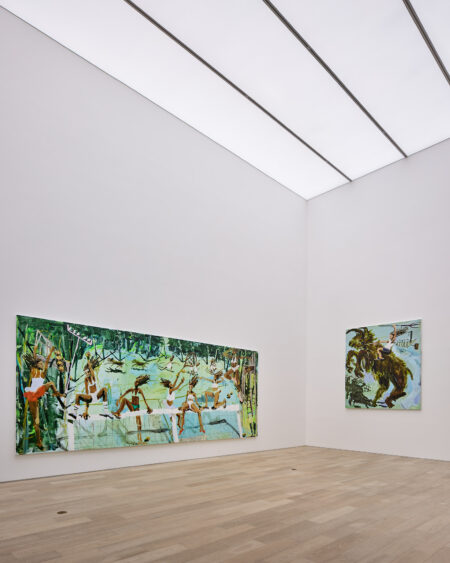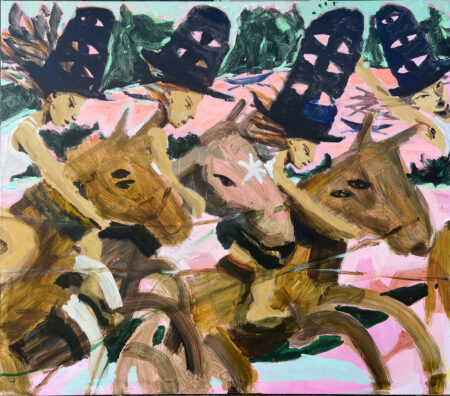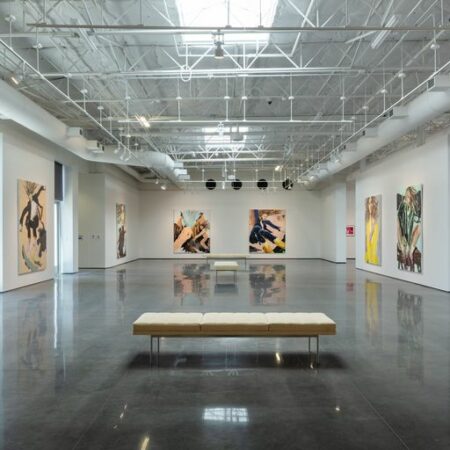RASMUS VESTERGAARD
Is the director of SNYK Skive Ny Kunstmuseum and Department Manager in Museum Salling. He is former Director of Skive Kunstmuseum (Skive Museum of Art). Present field of research is contemporary art including new media art and Modern Architecture and Design. Rasmus Vestergaard holds an MA (Research Degree) in Art History from the of University Aarhus.
COLLAPSE AND INTERPRETATION – ENDEAVOURS INTO THE REAL
Mie Olise’s artwork consists of both decay and reconstruction. The spectator is put into an undecided position. Are the sketchy motifs dissolving, are the cars of the fairground carousel running so fast that they splinter, are the splashes of paint signs of dissolution? Or, are the motifs arrested in time to show their movements, arrested in an attempt to catch and grasp the actual structure of an intensified moment? The answer is obvious – and at the same time out of reach. Mie Olise’s artwork offers a twofold journey. A journey to the land of recollection. A journey to the present moment. Her works lead us in two directions and are nourished by the inevitable clash between expectations and reality.
Using a deserted and decayed amusement park from East Berlin, Spreepark, as her starting point, Mie Olise embarks on a twofold journey. We all know the rush from the roller coaster, the sound of enthusiastic squeals, the sweet smell of candy floss, the inner thrill of excitement. Memories (both good and bad) are awakened when the word “funfair” are mentioned. We remember ourselves as children in a carefree universe. These expectations and memories are exactly what initiate the journey. However, the clash between this journey and the other one – the journey into the real world – is marked evidently. The funfair has been deserted, the amusements have been damaged, broken windows, silence prevails.
Initially the difference between recollection and reality is expressed through a feeling of melancholy that relates to the loss of the whole idea behind the amusement park. This feeling of melancholy is expressed most evidently in the video production MELANCHOLIC NOISE. In this work the handheld camera examines the reality that the decayed buildings and amusement activities represent with an almost insisting voyeurism. The camera captures the melancholic atmosphere and the physical condition of the place which is present in both the soundtrack and cine camera quality of the video. But at the same time the camera seems to question the present logic of the wrecked amusements – and the ideas behind them. This “archeological experiment of the senses” creates a thematic framework for the other works in the exhibition.
Mie Olise often works with projects that are based on a single concept that embraces the whole process of different artistic activities. Although all the works are autonomous, they also affect and enrich each other. The impressions and the different moods that MELANCHOLIC NOISE seems to pass on to the spectator are vigorously revived through a poetic logic that motivates the paintings and defines the constructive rules that apply to the gigantic structure COLLAPSING/RISING. Free and independent of the original setting. The actual funfair in Berlin is secondary. It offers an opportunity to move on. To reach something which is real, something with a deeper meaning. Spreepark is a conceptual starting point that ignites the clashes and the confrontations that create the energy in Mie Olise’s artwork. The contrast between our recollection (where we were) and our present reality (where we are now) is the crucial factor. Through a very concrete investigation, Mie Olise moves into decayed territory to register the difference between the original thoughts and idea and a present now. Accordingly she changes her way of looking at the world, and subsequently, in her paintings and constructions, she tries to reconstruct a new meaningful reality.
Mie Olise’s figurative language is very spontaneous, sensuous and powerful. She captures energy and holds the rough and potent quality of her works in check by focusing on the nuance of the detail. In the almost realistic paintings she aims at an artistic expression, where different worlds are put forward in a refined mixture of expressive wildness and delicate strength.
The abandoned place, which now presents itself as a transformed structure, is interpreted as a radically different reality. Mie Olise penetrates this reality, longing to find the essence of the real, the au- thentic quality of the present place. This endeavour makes it possible to relate Mie Olise’s artistic project to what can be characterized as a “neo-realistic approach”. Having this neo-realistic approach, the artistic process is based on a structural and relational relationship between reality and art. Neo-Realistic art creates a dialogue with our present reality by offering different ways of looking at the world and by establishing a dialogue with the viewer. By focusing on the neglected sides of life, we are given the opportunity to see the world again. Although this artistic practice has reality as its main objective, it does not necessarily seek congruency or resemblance between art and reality. The purpose is to maintain a focus on what is real and what is meaningful. Thus, what is real can and will not be uncovered or revealed in a spontaneous form based on “copying” the world. The real has to be a constructed and created extract.
The realistic practice is not tied to time and style, but has to be seen as a critical strategy which can be used to create an extract of reality – from an object or from any given context. It would limit the potential forces of realism if it was defined as an attempt to analyze, decode and interpret the physical world in relation to a political or religious definition of “truth”. The real is far more integrated in the new story, the new narration which is constructed by the artwork. The real is an interpretation of reality and it is a product of the dynamic interchange between object (the world) and subject (the artist).
This quest for meaning is an important element in Mie Olise’s artistic project. Several of her projects – including THE EXQUISITE CAPABILITIES OF THE FLYING CARPET – have their starting point in a world where the fundamental truth, what you believed in then, has literally shrunk. People have moved, are gone, do not use the place any long- er. The original stories that should carry these places into the future and support our search for meaning do not make sense anymore. It is tempting to see the parallels between the collapse of the Eastern- European systems and the decay of the fun fair, but this is just one way to approach Mie Olise’s project.


